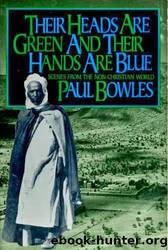Their Heads Are Green by Paul Bowles

Author:Paul Bowles
Language: eng
Format: epub
Published: 2015-07-01T16:00:00+00:00
THE RIF, TO MUSIC â¢
The most important single element in Moroccoâs folk culture is its music. In a land like this, where almost total illiteracy has been the rule, the production of written literature is of course negligible. On the other hand, like the Negroes of West Africa the Moroccans have a magnificent and highly evolved sense of rhythm which __ manifests itself in the twin arts of music and the dance. Islam, however, does not look with favour upon any sort of dancing, and thus the art of the dance, while being the natural mode of religious expression of the native population, has not been encouraged here since the arrival of the Moslem conquerors. At the same time, the very illiteracy which through the centuries has precluded the possibility of literature has abetted the development of music: the entire history and mythology of the people is clothed in song. Instrumentalists and singers have come into being in lieu of chroniclers and poets, and even during the most recent chapter in the countryâs evolution - the war for independence and the setting up of the present pre-democratic regime - each phase of the struggle has been celebrated in countless songs.
The neolithic Berbers have always had their own music, and they still have it. It is a highly percussive art, with complicated juxtapositions of rhythms, limited scalar range (often of no more than three adjacent tones) and a unique manner of vocalizing. Like most Africans, the Berbers developed a music of mass-participation, one whose psychological effects were aimed more often than not at causing hypnosis. When the Arabs invaded the land they brought with them music of a very different sort, addressed to the individual, seeking by sensory means to induce a state of philosophical speculativeness. In the middle of Moroccoâs hostile landscape they built their great walled cities, where they entrenched themselves, and from which they sent out soldiers to continue the conquest, southward into the Sudan, northward into Europe. With the importation of large numbers of Negro slaves the urban culture ceased being a purely Arabic one. (The child of a union between a female slave and her master was considered legitimate.) On the central plains and in the foothills of the mountains of the north the Berber music took on many elements of Arabic music, while in the pre-Sahara it borrowed from the Negroes, remaining a hybrid product in both cases. Only in the regions which remained generally inaccessible to non-Berbers - roughly speaking, the mountains themselves and the high plateaux, was Berber music left intact, a purely autochthonous art.
My stint, in attempting to record the music of Morocco, was to capture in the space of the six months which the Rockefeller Foundation allotted to me for the project, examples of every major musical genre to be found within the boundaries of the country. This required the close co-operation of the Moroccan government, everyone agreed. But with which branch of it? No one knew. Because the material was
Download
This site does not store any files on its server. We only index and link to content provided by other sites. Please contact the content providers to delete copyright contents if any and email us, we'll remove relevant links or contents immediately.
The Fine Print (Dreamland Billionaires Book 1) by Lauren Asher(2405)
Fury of Magnus by Graham McNeill(2364)
The Last House on Needless Street by Catriona Ward(2190)
The Rose Code by Kate Quinn(2088)
Malibu Rising by Taylor Jenkins Reid(1816)
Luster by Raven Leilani(1804)
Transcendent Kingdom by Yaa Gyasi(1772)
A Little Life: A Novel by Hanya Yanagihara(1771)
Moonflower Murders by Anthony Horowitz(1738)
The God of the Woods by Liz Moore(1583)
The Lost Book of the White (The Eldest Curses) by Cassandra Clare & Wesley Chu(1524)
This Changes Everything by Unknown(1426)
The Midwife Murders by James Patterson & Richard Dilallo(1382)
The Lying Life of Adults by Elena Ferrante(1353)
The New Wilderness by Diane Cook(1343)
Written in the Stars by Alexandria Bellefleur(1322)
Wandering in Strange Lands by Morgan Jerkins(1287)
Ambition and Desire: The Dangerous Life of Josephine Bonaparte by Kate Williams(1284)
The Lying Life of Adults by Elena Ferrante;(1237)
